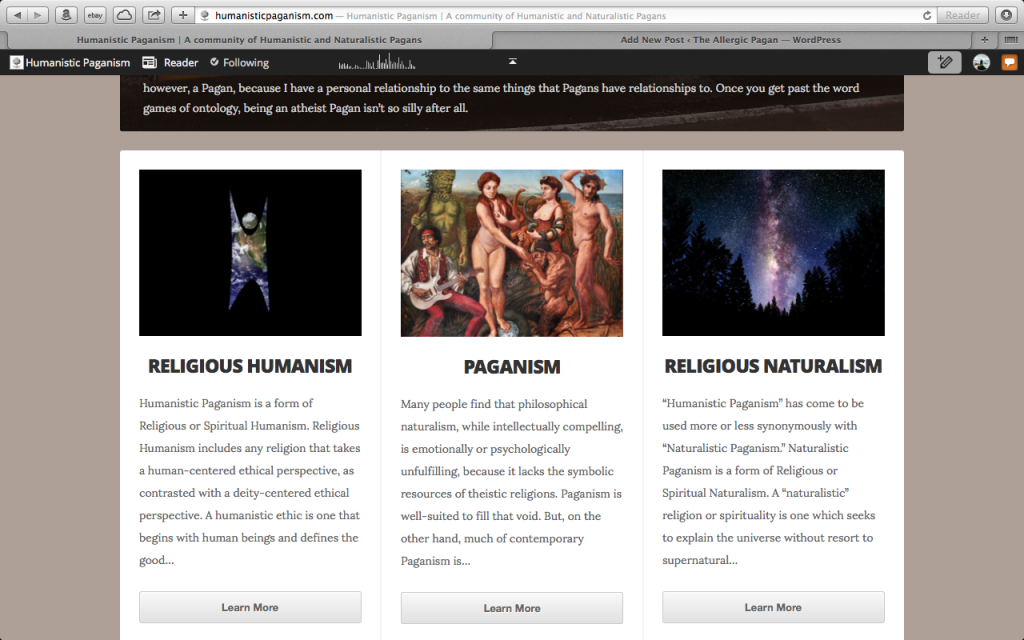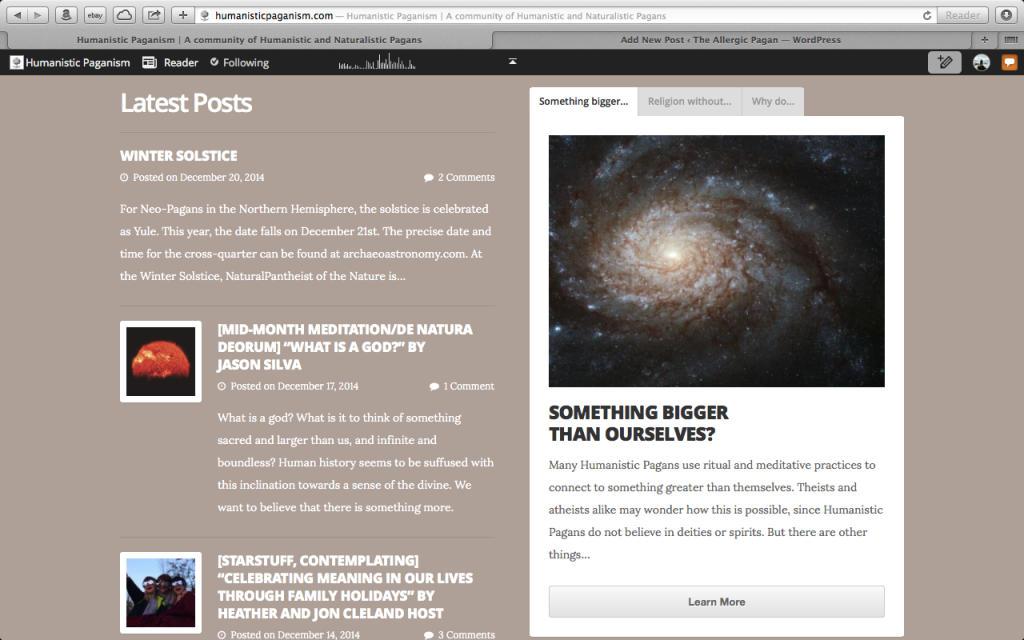HumanisticPaganism.com has gotten a facelift. Among the changes are an informative front page, a handsome look with a fun interface, and new articles about Humanistic Paganism.
 What is Humanistic Paganism?
What is Humanistic Paganism?
Humanistic Paganism, also called Naturalistic Paganism, is a unique Pagan orientation for those who are uncomfortable with or skeptical of the supernatural or metaphysical elements of contemporary Paganism. Individuals may use other self-descriptors, such as “Atheist Pagan”, “Atheist Witch”, “Pagan Humanist”, “Druid Naturalist”, etc. Humanistic Paganism has been described as Paganism without the “woo”. In affirmative terms, Humanistic Paganism is Paganism that is firmly rooted in the empirical world.
Many people come to Paganism after leaving Christianity or other monotheistic religions. Many are drawn to Paganism, or Neo paganismparticularly, because of its “this-worldly” orientation and the impulse to find the divine in the “here-and-now”. Neopaganism is often described as a religion of immanence, in contrast to religions of transcendence. This is manifest by the concept of a pantheistic Goddess, the seasonal Wheel of the Year, and a pro-body ethic.
 But a person drawn to Paganism by its down-to-earth orientation may be disturbed by other aspects of Paganism, such as the belief in instrumental magic (the belief that thought can cause change in the physical world without corresponding physical action), New Age trappings like crystals, or the literal belief in gods as sentient beings. For some, this kind of Paganism too closely resembles the other-worldliness of the transcendental religions we left behind. These Pagans may find a home among Humanistic Pagans who share a love of the myth and ritual of Paganism, but not what we see as its irrational credulity and superstition.
But a person drawn to Paganism by its down-to-earth orientation may be disturbed by other aspects of Paganism, such as the belief in instrumental magic (the belief that thought can cause change in the physical world without corresponding physical action), New Age trappings like crystals, or the literal belief in gods as sentient beings. For some, this kind of Paganism too closely resembles the other-worldliness of the transcendental religions we left behind. These Pagans may find a home among Humanistic Pagans who share a love of the myth and ritual of Paganism, but not what we see as its irrational credulity and superstition.
Others come to Humanistic Paganism not from theistic religions, but from non-religious backgrounds. Atheists may come to Humanistic Paganism looking for a spiritual practice to help them celebrate the natural world or experience a deeper connection to the Universe without abandoning their rational faculties.
Getting Started
There is no initiation for Humanistic Pagans to undergo. If you feel this path is right for you, all you need do is put it into action. Here are some things you can do:
- Learn about the world around you. There are many scientific resources, both published and on the Internet, which you can draw upon for this.
- Learn about the science of religion. Much has been written recently about both the positive and negative roles that religion plays in our psychology and in society.
- Spend time in nature. Use all of your senses. There is no substitute for direct experience of nature.
- Cultivate a sense of wonder at the universe and our place within it, from the most distant star to the smallest particles to the depths of human psychology.
- Read and meditate upon ancient pagan myths, as well as contemporary Neopagan myths.
- Join in rituals of other Neopagans, even if they are not naturalistic, or create your own.
- Apply the scientific method to your religious practice: experiment.
- Accept responsibility for your actions, especially for your impact on the environment, and embrace your responsibility to make the world a better place.
- Check out what other Humanistic and Naturalistic Pagans are doing. The HumanisticPaganism site and the Naturalistic Paganism Yahoo discussion group are excellent resources. Join the Humanistic Paganism Facebook page.












